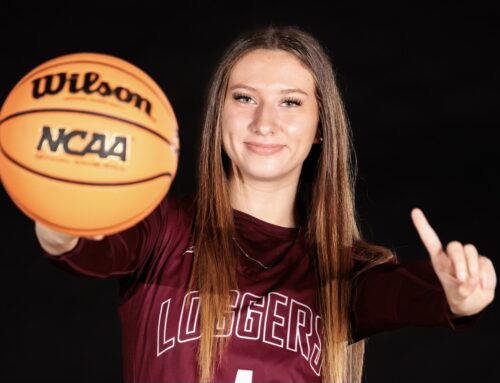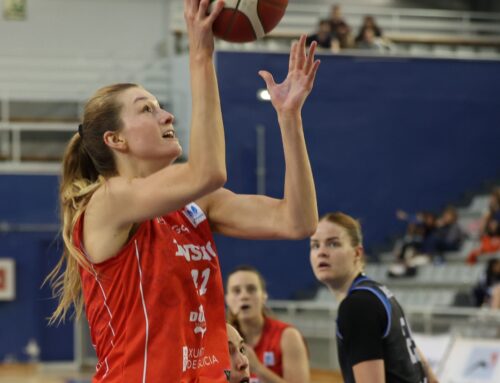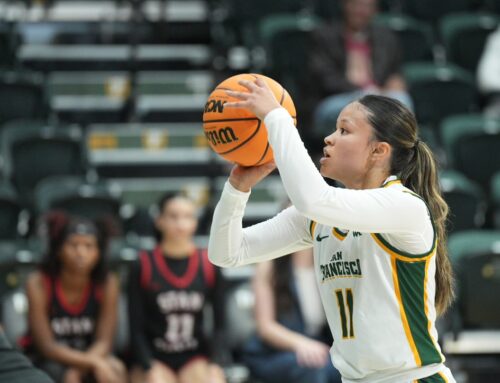The recent loss of Justice Ruth Bader Ginsburg has left me heartbroken. I didn’t have a personal connection to her, but what I know of her, I love, and I am grateful for how she fought for women’s rights and equal rights.
It is because of Justice Ruth Bader Ginsburg (and many other strong women before my time), that I have the right to vote, that I have access to birth control, that I was able to get a credit card before I was married and that, if I want, I can buy a house without my husband’s signature, to name a few.
And of course there’s Title IX (which bans sex discrimination and sexual harassment in federally subsidized educational programs, including athletics). This 1972 Education Amendment is what opened up doors for me to play the sport I love at the next level and get a better education, and for that I am grateful. Had I been in school a few years earlier, before Title IX, things may have been different.
Can I Play? Dreaming In The Wave Of Title IX is an article I published several years ago about how lucky I was to grow up after Title IX was enacted, and how it allowed me to pursue my dream of playing college basketball.
Can I Play? Dreaming In The Wave of Title IX by Sonya Elliott
“Mom, I want to play basketball,” I said as I watched the boys move up and down the court, dribbling around each other in an effort to get to the hoop. I was seven at the time.
My mom peered at me through the bottom of her glasses and explained, “They don’t have basketball for girls your age, Sonya.” But when I narrowed my eyes and huffed, she gave me an exaggerated wink and said, “That doesn’t mean you can’t play.”
Not long after, my dad took an old railroad tie from our landscaping, hoisted it vertically and cemented it into the ground, before attaching a wooden backboard and hoop so my brother and I could toss a basketball around with the kids in the neighborhood. Our two-handed toss was the beginning of my love affair with the game. Now at the age of forty-nine, I still play basketball and have spent more than twenty years coaching the game. I’ve seen many changes take place in the sport over my lifetime. Changes, that thanks to Title IX, opened doors for me, and other young women, to follow their dreams.
I was raised to believe that women are as capable as men, so it wasn’t until I started school that I understood the inequalities girls faced, and it wasn’t until I was an adult that I could fully comprehend how lucky I was to be raised during the years of Title IX. Since Congress enacted Title IX in 1972, opportunities in sports for girls have skyrocketed. According to the Women’s Sports Foundation, in 1972 (when I was six), just one in twenty-seven girls participated in high school sports; today, about two in five participate and the number of women playing at the college level has increased by more than 600 percent. Because of Title IX, which bans sex discrimination and sexual harassment in federally subsidized educational programs, including athletics, there are more athletic scholarships for women and opportunities to participate in sports and to learn from the game than ever before.
Back when I was in elementary school in Montana, I was taught 6-on-6 basketball, a game where each team has three offensive players and three defensive players on each half of the court. I didn’t know that 6-on-6 had been put into women’s play back in 1899, by the Women’s Basketball Rule Committee, because the committee believed the game of basketball was too rough for girls, I thought 6-on-6 was the way everyone played the game. And it wasn’t until I went to a men’s game at the University of Montana that I saw 5-on-5 basketball, real basketball. It looked like so much fun to run the full court and play both offense and defense and I was shocked to learn that girls weren’t allowed to play this way, even at the college level in some states. I wanted to play real basketball, and fortunately by the time I went to middle school, I got the chance. Although it wouldn’t be until years later (Oklahoma was the last state to change in 1995), that girls across America would all get to play real basketball. Playing full court 5-on-5 was so much more fun than waiting on one end of the court for the action to return. My middle school coaches made our girls team work hard, they didn’t believe in the pre-Title IX perception that girls were weak, so our team was strong. We lost just one game in three years.
In high school I held my own as a small, small forward, weighing in at a whopping one hundred twelve pounds and five foot seven inches tall. I played aggressive defense, guarding players twice my size, bumping them out of position as they cut, fighting them down low when they tried to post me up and blocking them off of the boards. It was my toughness, that thing that girls were not supposed to have, that me made me a good player. And because I love the game so much I put in extra hours shooting and working on ball handling and started to become one of the top basketball players in Spokane, Washington. I wanted to play at the next level, and although I was probably quite naïve at the time, I was certain I could get a scholarship. I attended summer camps and played on an AAU team that was put together by a coach in the area. I honed my skills, and by the end of my junior year, I was the second leading scorer in the Greater Spokane League, averaging over 17 points a game.
As spring hit, our AAU team, the Spokane All-Stars, gathered the top basketball players from Washington and Idaho and became a powerhouse. And after we played in the National AAU Tournament, I started to receive letters of interest from college basketball programs across the United States. I was getting letters from Washington to Southwest Louisiana, and was flatter that they and others like Oregon, Stanford and Columbia were considering me for their teams. All of the athletically talented girls who I’d known who had graduated prior to my senior year, either didn’t play sports in college or if they did, their college coach found them campus work to help pay for school, they didn’t receive athletic scholarships. It wasn’t until my senior year that I watched several of my AAU teammates get recruited and get their college education paid for.
I personally had my heart set on playing for the University of Montana. It was my grandpa’s alma mater, and although I moved to Washington as a girl, I had grown up watching Griz basketball. After my junior year I traveled to the U of M’s camp and had been voted Co-MVP. We kept in contact and I turned down other college visits knowing I was going to be a Grizzly. But a scholarship offer never came, and when I called the coach, I was stunned to hear that they’d used them all. There was no money left for me.
I was devastated. Looking back I wish I’d done things differently, explored my options more thoroughly and given myself the best opportunity to get a scholarship, but I would never want to change how things turned out. I scrambled, followed up with schools that had contacted me over my senior year and ended up playing on scholarship at Eastern Washington University. I got lucky.
There is nothing like stepping on a college court to play the game you love. And even though it made me mad that at times the women’s teams played in an old gym with dirty floors and missing light bulbs while the men played in a new college sports complex, my anger at such obvious inequality was damped by my thankfulness to just be on the court. To this day, things are not perfect. When I took over as the head coach of a girl’s high school basketball program in Seattle in 2010, I started with four dollars, four uniforms and a locker room that had been used as a dumping ground, but despite these inequities that still occur, we have come a long way from my six-on-six playing days. There are more girls’ teams, there are more athletic scholarships, and there are opportunities for women to play basketball overseas and in the WNBA after college.
When I watch a girl’s game from the bleachers now, I am often brought to tears. Not because I miss being on the court as a player or as a coach, but because, thanks to Title IX and the changes that have happened in women’s sports since I was first tossing a ball at a battered hoop in my driveway, this game that I love will have more impact than ever before on the lives of young women and they will no longer have to hear, “They don’t have basketball for girls.”
Instead they will hear, “Yes! Yes you can play.”




